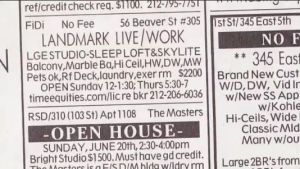An article was recently published in the New York Times echoing a sentiment I knew long ago. Boutique Real Estate Agencies such as ours are making strides in the market by leaps and bounds. But don’t just take our word for it..please read further to find out why….
Something must be working in the name or otherwise, because in less than five years, A. C. Lawrence has grown from five agents in a tiny Chelsea office to more than 100 in swankier Midtown digs on East 45th Street. The founders say the company stands out for its attention to training and low agent-to-manager ratio of seven or eight to one, and for its transparency. “There are no pocket listings within our company,” Mr. DeGrotta said. “If an agent knows of a listing, they don’t keep it to themselves” for competitive advantage. “They put it into our proprietary data base.”
The firm’s expansion — which took place during the rockiest property market in decades — raises an interesting question: Could we be heading toward an era of the little firm in New York real estate?
Big firms like the Corcoran Group and Prudential Douglas Elliman, with thousands of agents, still dominate the market, of course. (Elliman says it sells 33 homes a day.) But whether the clout of little firms is growing is an important question for buyers and sellers, as they decide between a highly visible name with vast listings and resources, and a smaller firm that promises to shower the client with individual attention, in many cases focusing on a particular segment of the market, like new downtown condos, prewar Classic 6’s or East Side brownstones.
Back in 2005, none other than Barbara Corcoran, the queen of big firms who built the multibillion-dollar Corcoran Group from a $1,000 (borrowed) investment, declared in a Business Week interview, “I think the future belongs to small brokers.”
She acknowledged that not many people held that view but went on to argue that while the big firms were richer and had more resources, the little ones were more creative and nimbler, having far less bureaucracy and layers of management. “We need to be responsive to a changing market,” Ms. Corcoran said. “And more often than not, the little guy can move. The big guy is still thinking about it.”
Reached last week, Ms. Corcoran, who sold her firm in 2001, stood by her pronouncement. “Definitely,” she said. “On the Internet everyone is equal. The small agent can look as classy as the big agent.” She added, “Ten years ago, if you wanted your property noticed you were far better off with large brokerage firms because they were the big buyers on the print ads. That’s out the window now.”
Shaun Osher, a top-producing broker at Douglas Elliman who left in 2005 to start his own firm, CORE, relies heavily on social media to get his firm’s name into the public eye, sometimes in subtle ways. Mr. Osher has a blog, COREtalks.com, where he sometimes muses on matters that range far afield from real estate. Last month, for example, he posted a video interview he had done with the designer Nicole Miller during New York Fashion Week.
The conversation touched only tangentially on real estate — but the interview went out on Twitter to all Ms. Miller’s followers (as well as, of course, Mr. Osher’s), and was picked up by numerous fashion blogs and other sites outside of the real estate realm.
Mr. Osher has also taken advantage of reality television, taking part in the HGTV reality show “Selling New York.” CORE, which started with four people, has grown to 50 agents and 16 staff members. The company focuses on new residential developments, many in downtown Manhattan.
One of the main things that any small business — whether an independent bookstore, a corner toy store or a neighborhood hardware store — would have customers believe is that service is better and personal attention greater at a little firm. Whether that is true in real estate depends — because the company name may be ubiquitous, but the client’s relationship is usually with a single person.
Nevertheless, Solomon Asser, the principal of the Tecny Group, a design-and-build firm, who would probably get a high level of service no matter where he went, said he thought there could be advantages to smaller firms like Leslie J. Garfield & Company, which currently has two of his listings, including a $26 million Upper East Side town house. “Dealing with a smaller firm goes with faster answers to things, quicker resolution to things,” Mr. Asser said. “You don’t need to get an answer from someone else to get something done.”
Inexperienced players can find smaller brokers less intimidating. When Kelly Snyder and her fiancé, Darien Ward, began hunting for their first home, they had trouble reaching the Elliman broker they were dealing with in Harlem.
It was like pulling teeth trying to get in touch with him,” Ms. Snyder recalled. She wondered if their age — she is 27, he is 32 — and price range had anything to do with it. She recalled thinking: “We’re not looking for a multimillion-dollar place. Are they slighting us because we won’t fill their wallet?”
“It was really, really frustrating,” Ms. Snyder said.
Then she saw some properties posted on Craigslist by Jennifer Ferland, an agent at A. C. Lawrence, and contacted her. “From the beginning she was a dream,” Ms. Snyder said. “She understood the process and how daunting it can be. She said: ‘Let’s go through this together. I’m here for you.’ ”
In the end, with Ms. Ferland’s guidance, they found a condo in Jersey City that they loved and, at around $300,000, was in their price range. They closed last fall and have been living there happily since.
Ms. Snyder says she doesn’t know if it was Ms. Ferland’s personality and work ethic that made her so effective or if it was that she worked for a smaller firm, but she suspects that size did have something to do with it. “I think when you have a huge corporation,” she said, “it just ends up being so micromanaged that you lose that sense of friendliness.”
Dottie Herman, the president of Prudential Douglas Elliman, says that no matter the size of the firm, there will always be clients who have issues with individual agents. But she stresses that the personal attention that people expect from small agencies is also part of the Elliman culture.
“We’re very hands on,” Ms. Herman said. She posts her e-mail address on the firm’s Web site and when she gets messages, she said, “I will respond to every single one of them.” If properties have problems, she said, she herself visits them. The money the firm spends on technology, marketing and research overpowers anything smaller firms can offer, she said.
Pamela Liebman, the president of the Corcoran Group, expressed similar sentiments. “We got to be big because we were very good,” she said, “and we grew based on the fact that we were so successful.”
Ms. Liebman says Corcoran has the resources to provide an in-house research department that assists agents, a training center and a 40-person tech department. The result, she said, is a Web site that receives four million hits a day, as well as innovations like Corcoran apps for the iPhone and Android. All that, she said, leads to better and more thorough service for clients. “Bigger does not mean less service,” she said. “To me, bigger should mean better service because we have more resources behind us.”
For all the small-firm talk about how technology has leveled the playing field, it can still present high hurdles. A few months ago, Michael Bolla gave up his independent brokerage, Luxury Lofts & Homes, to join Prudential Douglas Elliman because he was about to handle some large developments and was not willing to invest the money to upgrade the servers for his Web site to handle the increased volume in his listings.
“If you have a 120-unit development on a small guy’s Web site,” Mr. Bolla said, “it will crash.”
Many smaller firms say specialization is the key to success. Since its founding in 1988, D.G. Neary Realty has trained its sights on downtown Manhattan, specifically Chelsea and the West Village. The firm still has just one office — on the second floor of a building at 16th Street and Sixth Avenue. Though it now has agents posted elsewhere, including Harlem and the Upper West Side, downtown is the company’s stronghold.
“Real estate is a referral business to a large extent,” said Gil Neary, the founder. “If you have a reputation in a neighborhood, people see you and hear you and know you’re around and you’re available.” The focus, he said, means that his firm knows “the nuances of the neighborhood” — like the preferences of certain co-op boards, the finances of specific buildings, and the best grocery and barber.
“It’s not that other brokers don’t have that information,” Mr. Neary said. “But I think you have a certain amount of credibility by virtue of familiarity.”
Tami Hausman, a client of Mr. Neary’s, said that local expertise had proved valuable when she and her husband, James Crispino, were looking for a two-bedroom apartment in the Village. “It was especially important when we saw the apartment we are now in contract for,” she said. “Before we stepped in, I remember him saying to us, ‘If I was going to buy an apartment in the building, this is the line I would buy in.’
“He knew a lot about the history,” Ms. Hausman continued, “the kind of people who lived there, where it was in the building, that it was a stable building. Those are the kinds of questions you might ask later.”
Jed Garfield, the managing partner of Leslie J. Garfield & Company, the nine-broker firm that his father, Leslie, started in 1972, said 95 percent of his firm’s business was town houses. The company does business only in Manhattan, having embarked upon what Mr. Garfield describes as a “very unsuccessful foray” into Park Slope a few years ago.
To underscore his firm’s “single-minded focus on one type of asset,” he publishes a quarterly newsletter about town houses that he mails to every town-house owner in Manhattan. Sure, there have been temptations to branch out into co-ops and condos. But, Mr. Garfield said, “I felt, rightly or wrongly, that it would dilute the brand.
“If we can’t do one thing hopefully a little better than anyone else or know the market better, then what are we worth?”

 Heidi Spellman Realty, LLC
Heidi Spellman Realty, LLC 











